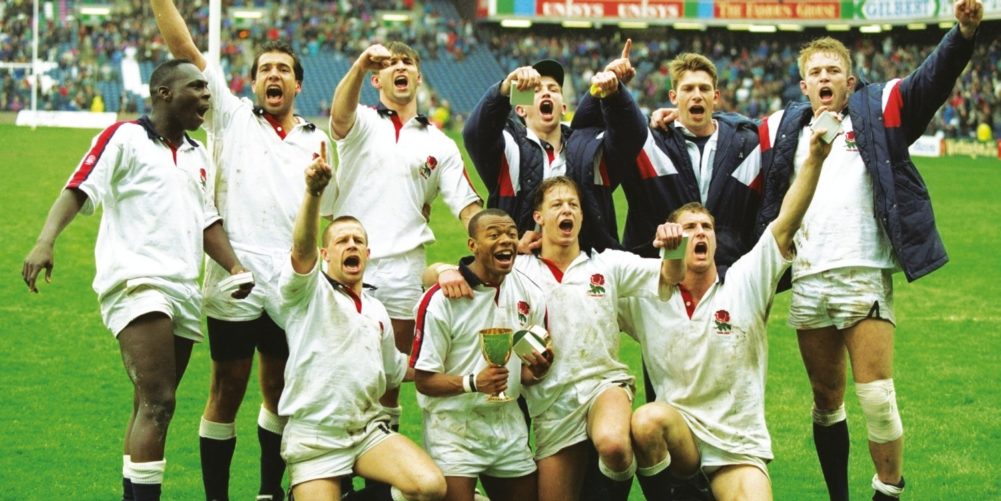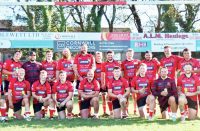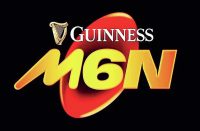Brendan Gallagher delves into some of rugby’s most enduring images, their story and why they are still so impactful

Iconic Rugby Pictures: PART 42
Unfancied England win Melrose Sevens April 16, 1993
What’s happening here?
It’s April 16, 1993 and the unfancied England squad have just walked off with the Melrose Cup – the inaugural World Sevens Championship – which had been staged over an exhausting wintry weekend at Murrayfield. A world title to add to the back-to-back Grand Slams of 1991 and 1992, not to mention that World Cup final appearance in 1991.
For those struggling to place names to faces, the victorious England squad was: Back row Adedayo Adebayo, Chris Sheasby, Justyn Cassell, Matt Dawson, Damian Hopley, Tim Rodber. Front row: Dave Scully, Andrew Harriman, Nick Beale, Lawrence Dallaglio
What’s the story behind the picture?
In fact there are a couple of story lines to dig into. First a hat-tip to the SRU who, 20 years after staging the World Invitation Sevens which England also won, went to the IRB with the proposal that an official World Sevens Championship should be contested every four years, midway between the world fifteens competition which was obviously here to stay after successful tournaments in 1987 and 1991.
The IRB liked the idea and Scotland were granted the first competition. Fiji and Samoa named specialist squads based on their successful Hong Kong Sevens teams while most of the other top nations filled their Sevens teams with their very best – and fastest – fifteens players.
South Africa, for example, included Joost van der Westhuizen, Chester Williams and Andre Joubert among their backs. England took a different view.
After three or four successful seasons under Will Carling they had underperformed badly in the 1993 Five Nations culminating in a poor defeat in Dublin. There needed to be a sweep for new talent. In addition, unwisely as it ultimately proved, the ageing England team had still been asked to form the bulk of the 1993 Lions squad and were looking for a couple of quiet weeks before departing for New Zealand.
So the England selectors got inventive. They picked just two capped players – Harriman who was capped only once and Tim Rodber who had made his debut the previous season – with the rest of the squad being made up by young tyros and Sevens specialists.
Harriman was their trump card. Underused and underappreciated by Geoff Cooke, Sevens coach Les Cusworth knew Harriman was the fastest wing in the world and the Quins man had a point to prove. Just get the ball to the Prince.
“Sevens coach Les Cusworth knew Harriman was the fastest wing in the world”
What happened next?
England began their preparations early in the week with a pub crawl around Edinburgh to celebrate Damian Hopley’s 23rd birthday and predictably got ran ragged the next morning in a practice match against Dundee HSFP. It could only get better… and it did.
“It was a very tough tournament with ten matches over three days but we were a fit side and that played into our hands a bit,” recalls Dallaglio, a second XV flanker with Wasps at the time. “A few years earlier I had played 14 matches in four days with Ampleforth at Rosslyn Park when we did the double so I knew these competitions were endurance tests.
“We won four of our five games in the first pool – losing only to a good Samoa side – and then we had the quarter-final pools with the top eight teams divided into two pools of four.
We beat New Zealand and South Africa and lost 21-12 to Australia but qualified for the semi-final against Fiji who we beat 21-14.
“The Prince got two tries and I grabbed one but a key moment was a fantastic try-saving tackle by Dave Scully from which we counterattacked and scored. A huge 14 point swing but that’s the way it goes in Sevens.” Australia awaited.
In the final England scored three tries in quick succession straight from the restarts – the conceding team had to restart in those days – to race into a 21-0 lead with Harriman’s smoking of David Campese on the outside the pick before the Aussies stormed back with three tries of their own – but Michael Lynagh could convert only one.
Why is the picture iconic?
Nobody rated England at the start of the tournament, nobody was talking about them other than to snigger at their defeat against Dundee HSOB with some claiming it was actually the Old Boys second string Seven.
The star-studded teams from Fiji, New Zealand, Australia, France, Samoa, South Africa and the hosts Scotland would surely duke it out. England would be also rans.
Well, by the end of the weekend everybody was talking about England. The pace of Harriman, the warrior spirit of Scully, the class of Beale and the massive potential of Dallaglio and Dawson.
Footnote: Dawson and Dallaglio went on to become double world champions, winning the Webb Ellis trophy with England over ten years later. They, along with Rodber and Beale, were also members of the victorious 1997 Lions squad.
























Pingback: ดูซีรี่ย์
Pingback: transport pneumatic